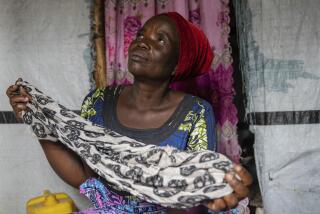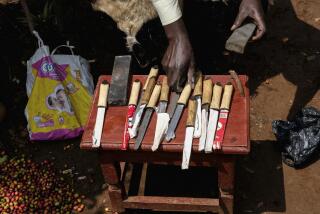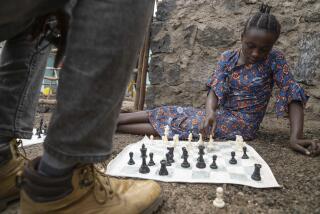Rwandaâs Youngest Killers
GITARAMA, Rwanda â Sylvert Sebazungu knows precisely why he is being held in a foul, densely packed room with no beds or lights deep inside the dungeon-like prison here.
âThey say I was in a gang that was killing children,â he said, averting his gaze. âWith sticks and machetes and guns.â
Then he looked up, his eyes hard and dark. âIt is not true,â he declared. âI stayed at home.â
Wherever he was, Sebazungu was 15 years old at the time. But like the 47 other boys crammed on the floor in the dismal juvenile ward at the Gitarama prison, and about 2,200 youths incarcerated in other hellish jails across the country, he is being charged with committing acts of genocide.
Rwandaâs agony as it grapples with the legacy of the 1994 ethnic slaughter and civil war thus has a new horror: For the first time in known history, children are being held accountable for mass murder.
âYouâre not talking about small infractions,â said Ray Torres, a UNICEF official. âYouâre talking about children who killed 10 or more people.â
He shook his head at the thought. âYouâve had situations before where children participated in war crimes, in Cambodia, Angola or Nicaragua,â he added. âBut until now, no child has ever been charged with crimes against humanity.â
The young defendants invariably deny culpability or insist they have forgotten what happened. Countless other Rwandans, the survivors of genocide, canât forget the atrocities. They are tormented day and night by searing images of pain and loss.
âSo many children saw their parents tortured, their mothers raped, their fathers hacked to death, their sisters nailed to trees,â warned Evode Kazasomako, head of the National Trauma Center, which coordinates a national training and treatment program for severely affected children and their families.
Zealots in Rwandaâs Hutu-dominated former regime orchestrated the ethnic genocide, enlisting priests, teachers, community leaders and civilian mobs to help massacre more than 800,000 Tutsis and moderate Hutus in a 100-day rampage.
Unlike the genocide committed by the Nazis, who hid their gas chambers in distant death camps, most of the killing here was done in public and by the public--including children.
For many youths, the choice was to kill or be killed.
Some youngsters followed their parents in frenzied machete attacks on former friends and neighbors. But others led some of the savagery, hunting Tutsis in deadly packs in an all-too-real version of the novel âLord of the Flies.â
âMostly, they were killing their fellow children,â said Ibel Ziliguru, assistant director of Gitarama prison. âEven the youngest ones.â
Anyone who was 14 or older during the butchery may be charged under recent Rwandan law. If convicted, those younger than 18 will face prison sentences of up to about 20 years. Unlike adults, teens are exempt from life imprisonment and the death penalty. The first trial of an adolescent is expected to begin in April.
Special genocide courts have sentenced at least 11 adults to the firing squad and several others to life imprisonment in trials that began in December. Human rights groups complain that many of those convicted so far didnât even have lawyers.
*
But the crisis is far more fundamental: About 95,000 inmates, including minors, now pack prisons and jails on genocide-related charges. Trying them all in a judicial system being built from scratch would take decades. The government hopes that most, including the minors, will plead guilty in exchange for reduced prison terms.
In the meantime, UNICEF has built separate wards for juveniles in nine prisons to protect them from rapes, beatings and other abuses.
It is a bitter first for humanitarian groups known for feeding and schooling children, not jailing them. But after fierce internal debate, UNICEF officials decided they had no legal or moral grounds to seek blanket amnesty for minors accused of crimes against humanity.
âWe were aware some donors might say, âI donât want to give money to UNICEF to build prisons for children,â â Torres said. âBut we felt very strongly this was in the best interest of the children. They are very vulnerable to abuse in prison.â
UNICEF will train several dozen judges, prosecutors and investigators in juvenile justice and childrenâs rights. It also will train and pay for defense lawyers for accused youths, as well as lawyers to represent their victims.
Children who were younger than 14 during the genocide will not be held legally responsible for their crimes, the government announced last year.
They are being held instead at the government-run âreeducation centerâ at Gitagata, a neat, fenced compound shaded by tall eucalyptus trees and flanked by flower gardens an hourâs drive south of Kigali, the capital.
The 197 boys at Gitagata appear healthy and well groomed. They go to school each morning and learn carpentry, sewing or other trades. Their bunk beds are jammed in four gloomy rooms with barred windows with broken screens.
Workmen are building a dormitory for about 240 more underage children still held in prison. The government says all those at Gitagata eventually will be released to their families, assuming relatives are still alive and not in prison.
âThese children are accused of participating in genocide,â said Louis de Montfort, director of the reformatory. âBut really, they are also victims of the genocide. They are too young.â
Itâs difficult to know how much the boys understand of their alleged crimes. Like their elders in prison, most already have learned to deny involvement. And age may be deceptive: Children often are entrusted with adult responsibilities, such as tending cattle.
âI remember war, thatâs all,â said sweet-faced Claude, who is 9, likes chewing gum and is accused of tossing a hand grenade into a neighborâs home, killing the family inside.
Tusabe, 12, wears a baggy green shirt and a shy grin. âThey say I had bad manners,â he said timidly, digging his bare toes in the dirt. âThey say I killed many people.â
Emmanuel, 10 and frail, insisted he did nothing. Asked what he remembered of the carnage in his village in Butare province, he stared into the distance and his voice fell to a whisper.
âI saw people killing other children with knives and spears,â he said. Where? âEverywhere. In schools, in churches, on the road.â
Only a few of the children at Gitagata have shown symptoms of emotional trauma despite such gruesome memories. âWe have seen some with nightmares, convulsions and hallucinations,â said Eugenie Mukanoheli, a UNICEF trauma expert. âWe can assume there are more.
âThe survivors have the possibilities to talk about their problems. The [accused] must keep quiet because they are charged and donât want to admit anything. They canât speak about it.â
*
Indeed, the pain of the past clearly tortures many of Rwandaâs children, according to a UNICEF study based on interviews with 3,030 of them across the country.
Nearly 80% of those interviewed had lost immediate family members, and many witnessed the slayings. More than one-third saw other children take part in killings. Nearly all heard family or friends plead for their lives or scream in pain, and saw corpses and hacked body parts.
âThereâs no baseline in history to compare with what weâre seeing in the children in Rwanda,â said Leila Gupta, a UNICEF expert on trauma and grieving who is in charge of the research project. âNot even with Holocaust survivors.â
Nearly one-third of the children interviewed witnessed sexual assault, often gang rape. The majority saw their homes burned or destroyed. And 16% hid under dead bodies to escape being killed. Many clearly are haunted by the horrors they experienced.
âWe asked children what they want to be when they grow up,â Gupta said, describing the survey. âMany just said, âAlive.â â
Symptoms of the trauma vary. Some children suffer night terrors and scream out in their sleep. Others stop eating or talking. Some are dangerously aggressive, others totally withdrawn.
âSome children, when they see a soldier with a gun, literally pass out on the street,â Gupta said. âOthers run away or scream.â
*
The National Trauma Center, which opened in September 1995 on the outskirts of Kigali, has helped train thousands of teachers, social workers, health workers and others to recognize severe trauma and help heal it. Radio, the only mass medium in Rwanda, is used to raise public awareness.
The treatment is rudimentary, and cultural barriers are high in a society where it is inappropriate to show emotion. But traumatized children are urged to express their suffering, their fear and their grief through singing, drawing and writing stories or poems.
On a recent morning, social worker Agnace Mukanyarwaya quietly counseled several children at the barracks-like hospital in the town of Nyanza, about 20 miles south of Gitarama. Her first patient, Fred, was 6.
âHe doesnât sleep,â Mukanyarwaya said. âHe has headaches full time. He has fear always. He wonât talk to anyone. He just stays alone. And he cries.â
She gave him a piece of paper and several colored pencils. She later explained his jagged lines and crude stick figures.
âHe draws the road,â she said. âThen he draws two or three boys happy and playing football. Then the militia comes and kills all the boys with machetes and throws him down the hole [mass grave] with the bodies.â
She paused, then added: âSome of these children are in a living hell. Sometimes I cannot stop crying when they start crying.â
More to Read
Sign up for Essential California
The most important California stories and recommendations in your inbox every morning.
You may occasionally receive promotional content from the Los Angeles Times.










